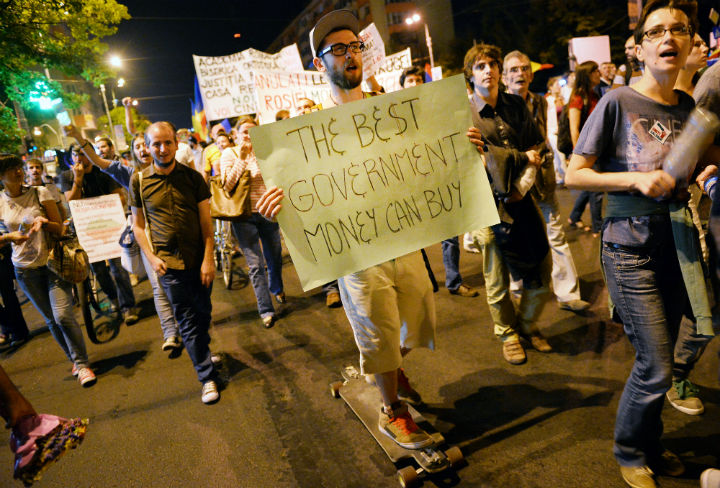VANCOUVER – Anti-mining protesters appear to have won their battle against the Romanian government and a Canadian firm planning to build Europe’s largest open-cast gold mine.

At least for now.
After more than a week of rallies in the capital city of Bucharest and the country’s second-largest city of Cluj Napoca, Romanian Prime Minister Victor Ponta said Monday the project likely won’t get approval.
READ MORE: Romanians protest Canadian-owned gold mining operation
A majority of Romanian parliament members weren’t in favour of the mine proposal for the northwest mountain community of Rosia Montana, and Ponta asked parliamentarians to vote quickly on draft legislation that would have moved the proposal forward.
“There’s no point in wasting time, I want to make sure that the Senate and the Chamber of Deputies vote on the rejection and then this project is closed,” Ponta said, according to Bloomberg News on Monday. “I don’t want the government to be responsible for contracts undertaken by previous cabinets.”
The state-run mine Rosia Montana was shut down in 2006, before the government shut down much of industry ahead of joining the EU.
Whitehorse, Yukon and London, England-based Gabriel Resources had hoped they would have approval for the Rosia Montana project by November, with plans for the mine’s first gold pour to come by late 2016.
The company is now considering its legal options.
“If the draft legislation is rejected then the Company will assess all possible actions open to it, including the formal notification of its intentions to commence litigation for multiple breaches of international investment treaties,” a statement from Gabriel Resources reads.
Activists, environmentalists and other anti-mine protesters took their issues with the open-cast mine and the use of cyanide in gold extraction to the streets for eight straight days, with between 8,000 and 10,000 people (estimates vary) rallying on Sunday, clearly swaying political opinion on a project that has been in the works for about 15 years.
Experts in mining and earth sciences say talk of using cyanide — a very toxic substance that is used to extract gold from ore in most of the world’s open-cast gold mining operations — often becomes the big issue, but it shouldn’t be the main concern.
What are the risks of using cyanide?
According to some reports, the project would use as much as 12,000 tons of cyanide annually. Gabriel Resources said the Rosia Montana mine would have a 16-year life.
UBC mining engineering professor Dr. Marcello Veiga points out the word cyanide generally sparks fear in people because of some notorious incidences.
“It’s a perception because the name cyanide usually can cause a lot of fear, especially because of Jim Jones (the leader of a cult in Jamestown, Guyana where 909 people died of cyanide poisoning in a 1978 murder/suicide) or because the Omai accident (also in Guyana)… because of the Kyrgyzstan accident,” he says.
He’s referring to a 1995 incident at a Canadian-owned mine in Guyana, where more than 1.2 billion litres of cyanide solution spilled into the Essequibo River, and a 1998 spill at another Canadian-owned mine in Kyrgyzstan that reportedly sickened 600 people.
Romania also suffered from a major cyanide incident in 2000, about 200 kilometres away from the proposed Rosia Montana modernization project, when approximately 100,000 cubic metrtes of cyanide-laced water spilled over the dam at the Baia Mare mine.
No one died because of the spill, but there was a huge fish and wildlife kill after the water flowed into Romania’s Somes River, then into Hungary’s Tisza River and the Danube River.
Although he admits accidents have happened, Veiga says there isn’t a risk to human life because of the mining industry’s use of cyanide. He says more people die from consuming bitter cassava in a year than from direct cyanide poisoning, let alone from cyanide used in mining.
Certain types of cassava — a major staple in the diets of people living in tropical countries — can actually produce fatal amounts of cyanide in the human body if not prepared properly.
A bigger issue for him is artisanal or informal gold miners aren’t held to strict guidelines.
“Artisanal miners use millions of tonnes of cyanide and nobody says anything,” Veiga says.
He says there is an illusion that artisanal or informal miners are just small operations with no backing, but he explains in many cases there are bigger operations running the show behind the scenes and it’s all unregulated.
He says he visits Ecuador several times a year in an attempt to educate artisanal miners about the risks of dumping higher concentrations of cyanide directly into rivers, which flow south towards Peru.
But, that’s far from the only place in the world where that happens.
He says there are 15 million artisanal gold miners around the world, producing about 400-450 tonnes of gold per year — a fraction of the 2800 tonnes of gold produced by corporate mining operations.
University New Brunswick Earth Sciences professor David Lentz says regulated mining operations have an interest in not letting cyanide go to waste.
He says mining companies are about making money. “They’re also about making money,” he says. “Any way of preserving and utilizing their cyanide over and over again is obviously what they want.”
It does happen though, he says, through structure failures and tailing dam breaches or accidents in transporting cyanide, such as what happened in Kyrgyzstan when a truck overturned and dumped almost two tons of sodium cyanide into a river flowing into the country’s biggest lake.
He said there would be a definite risk if you consume water containing cyanide immediately after a spill, but as it breaks down and dissipates over the course of a few days the risk decreases.
“It does collect in the food chain a bit, but eventually it’s going to dissipate.”
Ottawa-based Mining Watch Canada spokesperson Jamie Kneen says the experts are correct in saying there are less risks when everything works as planned.
He says you only have to look at nuclear power plants to see the potential for a catastrophe. “They don’t blow up very often,” he says. “But, when they do blow up… holy smoke.”
Both Veiga and Kneen concur there are also social issues that create opposition to big mining operations, and that is also the case with Rosia Montana.
One of the aspects of the draft legislation that appears to be quashed is that Rosia Montana Gold Corp. — the company Gabriel Resources formed in partnership with the Romanian government — would have made it easier for the company to expropriate land.
“You don’t usually give a third party to expropriate,” Kneen says, explaining that’s usually up to a government. He worries that would create a risk for the mining company to use private security to evict people from land they don’t want to give up.








Comments